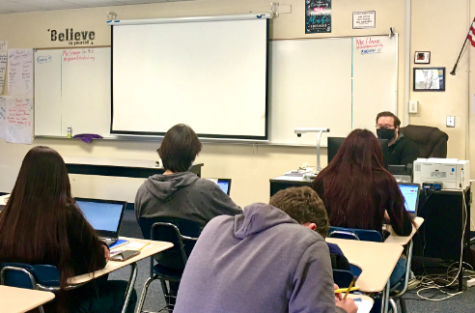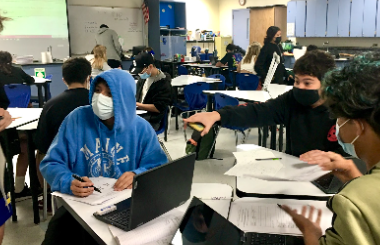Inside SPHS Classrooms
All Images by Neilana Corrales
May 3, 2022
In a school with over 100 educators, countless of our SPHS teachers’ classroom methods go unnoticed, so I sought to capture these styles, many of which occur in my own classes.

For example, Debbie Borunda, a math and ELD teacher at SPHS, says she establishes a firm, but the fun relationship with her students. She tries to foster strong connections with all her classes, so her students feel comfortable in confiding to her any questions or concerns they may have.
Borunda also understands what students personally want in a class. Mainly, students dislike staying silent and being instructed what to do for a prolonged period of time. Instead, they prefer being included in how the classroom operates.


“[Students] should learn when doing stuff instead of just hearing stuff… I think students generally will be more engaged if they’re doing something,” says Julie Baker-Conte, a biology teacher at San Pasqual High School.
Furthermore, Jennifer Franey, one of San Pasqual’s English 10 Honors teachers, doesn’t partake in long lectures, limiting her “teacher talk” to no more than 10 minutes. She would rather allot more class time for students to discuss rather than listen.


Similarly, David Squibb, a Math 1 teacher at SPHS, explains his teaching style as a “discovery-based approach.” This means students are given autonomy to discover the relationships between different concepts and numbers for themselves. Through this process, students better understand concepts, and their brains retain the information longer. Also, Squibb makes a huge emphasis on group work rather than individual work because it helps students build an understanding of complicated topics and improves their collaboration skills.
However, according to Baker-Conte, even though interactive activities help students learn more, many teachers do not plan lessons in that style often because it takes too much effort.


Nevertheless, most teachers at San Pasqual High School use a restorative practice which means they want to build strong connections with their students to create a supportive atmosphere.
For instance, San Pasqual High School’s English 9 honors and prep teacher, Ron Rogers, describes his teaching style to be strict but fair. However, during his classes, Rogers says he still tries to incorporate a lot of music, sarcasm, and laughter to create a relaxed, welcoming atmosphere. As a whole, he believes that inclusion is essential for a classroom.
“[Inclusion] helps the teachers establish the community of the classroom early on in the semester,” says Rogers.

Even teachers who aren’t that close with their students care deeply about them and want to help in times of need. Baker-Conte is one of these teachers, identifying as a “meh” teacher, who is generally in the middle: not too excessively friendly and not too overly mean. Though self-described as not open and warm, she is extremely dedicated and trustworthy. She is there for her students and will help with any of their struggles.

Franey implements this style of teaching into her lessons too; she calls it “student-focused.” Essentially, she lets her students be the center of attention in all of her lesson plans or unit goals. This means always considering her students’ inputs and opinions by heeding their feedback. Franey explains she often uses polls, asks questions about their understanding, collects index cards from them, uses Google Forms, etc. to figure out what her students actually need rather than leaving it up to guesswork.
“Students are our clientele; we work for students,” she says. “So, that’s what I try to remember each day.”


